 W
WAbaqus FEA is a software suite for finite element analysis and computer-aided engineering, originally released in 1978. The name and logo of this software are based on the abacus calculation tool. The Abaqus product suite consists of five core software products:Abaqus/CAE, or "Complete Abaqus Environment". It is a software application used for both the modeling and analysis of mechanical components and assemblies (pre-processing) and visualizing the finite element analysis result. A subset of Abaqus/CAE including only the post-processing module can be launched independently in the Abaqus/Viewer product. Abaqus/Standard, a general-purpose Finite-Element analyzer that employs implicit integration scheme (traditional). Abaqus/Explicit, a special-purpose Finite-Element analyzer that employs explicit integration scheme to solve highly nonlinear systems with many complex contacts under transient loads. Abaqus/CFD, a Computational Fluid Dynamics software application which provides advanced computational fluid dynamics capabilities with extensive support for preprocessing and postprocessing provided in Abaqus/CAE. Abaqus/Electromagnetic, a Computational electromagnetics software application which solves advanced computational electromagnetic problems.
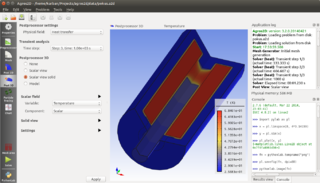 W
WAgros2D is an open-source code for numerical solutions of 2D coupled problems in technical disciplines. Its principal part is a user interface serving for complete preprocessing and postprocessing of the tasks. The processor is based on the library Hermes containing the most advanced numerical algorithms for monolithic and fully adaptive solution of systems of generally nonlinear and nonstationary partial differential equations (PDEs) based on hp-FEM. Both parts of the code are written in C++.
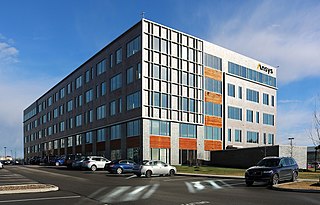 W
WAnsys, Inc. is an American company based in Canonsburg, Pennsylvania. It develops and markets multiphysics engineering simulation software for product design, testing and operation and offers its products and services to customers worldwide. Ansys was founded in 1970 by John Swanson. Swanson sold his interest in the company to venture capitalists in 1993. Ansys went public on NASDAQ in 1996. In the 2000s, Ansys made numerous acquisitions of other engineering design companies, acquiring additional technology for fluid dynamics, electronics design, and other physics analysis. Ansys became a component of the NASDAQ-100 index on December 23, 2019.
 W
WAutodesk Simulation is a general-purpose multiphysics finite element analysis software package initially developed by ALGOR Incorporated and acquired by Autodesk in January 2009. It is intended for use with Microsoft Windows and Linux operating systems. It is distributed in a number of different core packages to cater to specific applications, such as mechanical event simulation and computational fluid dynamics.
 W
WCalculiX is a free and open-source finite-element analysis application that uses an input format similar to Abaqus. It has an implicit and explicit solver (CCX) written by Guido Dhondt and a pre- and post-processor (CGX) written by Klaus Wittig. The original software was written for the Linux operating system. Convergent Mechanical has ported the application to the Windows operating system.
 W
WCOMSOL Multiphysics is a cross-platform finite element analysis, solver and multiphysics simulation software. It allows conventional physics-based user interfaces and coupled systems of partial differential equations (PDEs). COMSOL provides an IDE and unified workflow for electrical, mechanical, fluid, acoustics, and chemical applications.
 W
WDIANA is a Finite Element Analysis (FEA) solver that does basic and advanced analysis of various structures. DIANA FEA BV develops the software and with several resellers, distributes it worldwide. A selection of material models, element libraries, and analysis procedures within the package gives DIANA flexibility. Engineers have used DIANA to design and analyse dams and dikes, tunnels and underground structures, oil & gas, historical constructions, and large reinforced concrete structures. Some specialised analyses available in DIANA for these fields of use include seismic analysis, fire analysis, and young hardening concrete.
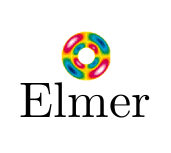 W
WElmer is computational tool for multi-physics problems. It has been developed by CSC in collaboration with Finnish universities, research laboratories and industry. Elmer FEM solver is free and open-source software, subject to the requirements of the GNU General Public License (GPL), version 2 or any later.
 W
WFEATool Multiphysics is a physics, finite element analysis (FEA), and PDE simulation toolbox. FEATool Multiphysics features the ability to model fully coupled heat transfer, fluid dynamics, chemical engineering, structural mechanics, fluid-structure interaction (FSI), electromagnetics, as well as user-defined and custom PDE problems in 1D, 2D (axisymmetry), or 3D, all within a graphical user interface (GUI) or optionally as script files. FEATool has been employed and used in academic research, teaching, and industrial engineering simulation contexts.
 W
WThe FEniCS Project is a collection of free and open-source software components with the common goal to enable automated solution of differential equations. The components provide scientific computing tools for working with computational meshes, finite-element variational formulations of ordinary and partial differential equations, and numerical linear algebra.
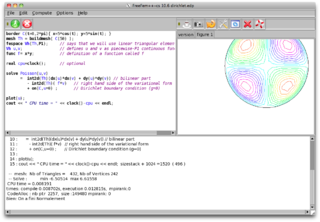 W
WFreeFem++ is a programming language and a software focused on solving partial differential equations using the finite element method. FreeFem++ is written in C++ and developed and maintained by Université Pierre et Marie Curie and Laboratoire Jacques-Louis Lions. It runs on Linux, Solaris, macOS and MS Windows systems. FreeFem++ is free software (LGPL).
 W
WGetFEM++ is a generic finite element C++ library with interfaces for Python, Matlab and Scilab. It aims at providing finite element methods and elementary matrix computations for solving linear and non-linear problems numerically. Its flexibility in choosing among different finite element approximations and numerical integration methods is one of its distinguishing characteristics.
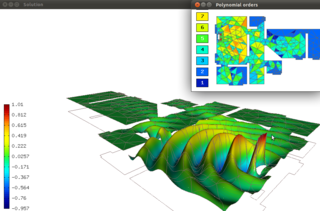 W
WHermes2D is a C++/Python library of algorithms for rapid development of adaptive hp-FEM solvers. hp-FEM is a modern version of the finite element method (FEM) that is capable of extremely fast, exponential convergence.
 W
WJCMsuite is a finite element analysis software package for the simulation and analysis of electromagnetic waves, elasticity and heat conduction. It also allows a mutual coupling between its optical, heat conduction and continuum mechanics solvers. The software is mainly applied for the analysis and optimization of nanooptical and microoptical systems. Its applications in research and development projects include dimensional metrology systems, photolithographic systems, photonic crystal fibers, VCSELs, Quantum-Dot emitters, light trapping in solar cells, and plasmonic systems. The design tasks can be embedded into the high-level scripting languages MATLAB and Python, enabling a scripting of design setups in order to define parameter dependent problems or to run parameter scans.
 W
WJMAG is simulation software for the development and design of electrical devices. JMAG was originally released in 1983 as a tool to support design for devices such as motors, actuators, circuit components, and antennas.
 W
WKIVA is a family of Fortran-based Computational Fluid Dynamics software developed by Los Alamos National Laboratory (LANL). The software predicts complex fuel and air flows as well as ignition, combustion, and pollutant-formation processes in engines. The KIVA models have been used to understand combustion chemistry processes, such as auto-ignition of fuels, and to optimize diesel engines for high efficiency and low emissions. General Motors has used KIVA in the development of direct-injection, stratified charge gasoline engines as well as the fast burn, homogeneous-charge gasoline engine. Cummins reduced development time and cost by 10%–15% using KIVA to develop its high-efficiency 2007 ISB 6.7-L diesel engine that was able to meet 2010 emission standards in 2007. At the same time, the company realized a more robust design and improved fuel economy while meeting all environmental and customer constraints.
 W
WLS-DYNA is an advanced general-purpose multiphysics simulation software package developed by the former Livermore Software Technology Corporation (LSTC), which was acquired by Ansys in 2019. While the package continues to contain more and more possibilities for the calculation of many complex, real world problems, its origins and core-competency lie in highly nonlinear transient dynamic finite element analysis (FEA) using explicit time integration. LS-DYNA is used by the automobile, aerospace, construction and civil engineering, military, manufacturing, and bioengineering industries.
 W
WNEi Nastran was an engineering analysis and simulation software product of NEi Software Based on NASA's Structural Analysis program NASTRAN, the software is a finite element analysis (FEA) solver used to generate solutions for linear and nonlinear stress, dynamics, and heat transfer characteristics of structures and mechanical components. NEi Nastran software is used with all major industry pre and post processors including Femap, a product of Siemens PLM Software, in house brands NEi Nastran in-CAD, NEi Fusion, and NEi Works for SolidWorks. This software was acquired by Autodesk in May 2014.
 W
WRange Software is finite element analysis software package.